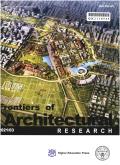Assessment framework of walking satisfaction on sidewalks in commercial districts: Combining built environment and personal attributes (applied in Japan)
IF 3.6
1区 艺术学
0 ARCHITECTURE
引用次数: 0
Abstract
Researchers are increasingly interested in the impact of the built environment on urban walkability. Pedestrian satisfaction is a key indicator of walkability and can elucidate latent factors to improve walking environment. This study develops an assessment framework for evaluating walking satisfaction on sidewalks in commercial districts in Japan according to the built environment and personal attributes. Questionnaire surveys were used to collect data from 963 Japanese residents' impact ratings of built environment variables. Six factors were extracted following exploratory factor analysis. Second-order confirmatory factor analysis was then applied to further explore the relationship between observed variables and latent factors. Latent class analysis was employed to classify the population, and personal attributes served as covariates in the multinomial logistic regression analysis to explore how these attributes affected the latent classes. The results indicated that visual impression, spatial richness, accessibility, comfort, diversity, and security influence pedestrian walking satisfaction on sidewalks in commercial districts. Travel purpose and travel method are important indicators that influence the latent classes of the population. The result presented herein can guide policy makers to optimize the construction of walkable urban environments and enact policies based on the factors and populations that are best suited to urban development.
商业街人行道步行满意度评价框架——结合建筑环境与个人属性(日本应用)
研究人员对建筑环境对城市可步行性的影响越来越感兴趣。行人满意度是步行性的关键指标,可以阐明改善步行环境的潜在因素。本研究根据建筑环境和个人属性,开发了日本商业区人行道步行满意度的评估框架。采用问卷调查法收集963名日本居民对建筑环境变量的影响评级数据。探索性因子分析提取6个因子。采用二阶验证性因子分析进一步探讨观察变量与潜在因素之间的关系。使用潜在类别分析对总体进行分类,并将个人属性作为协变量进行多项逻辑回归分析,探讨这些属性对潜在类别的影响。结果表明:视觉印象、空间丰富度、可达性、舒适性、多样性和安全性对商业街行人步行满意度有影响。旅游目的和旅游方式是影响人口潜在阶层的重要指标。研究结果可以指导决策者优化城市步行环境建设,并根据最适合城市发展的因素和人群制定政策。
本文章由计算机程序翻译,如有差异,请以英文原文为准。
求助全文
约1分钟内获得全文
求助全文
来源期刊

Frontiers of Architectural Research
ARCHITECTURE-
CiteScore
6.20
自引率
2.90%
发文量
430
审稿时长
30 weeks
期刊介绍:
Frontiers of Architectural Research is an international journal that publishes original research papers, review articles, and case studies to promote rapid communication and exchange among scholars, architects, and engineers. This journal introduces and reviews significant and pioneering achievements in the field of architecture research. Subject areas include the primary branches of architecture, such as architectural design and theory, architectural science and technology, urban planning, landscaping architecture, existing building renovation, and architectural heritage conservation. The journal encourages studies based on a rigorous scientific approach and state-of-the-art technology. All published papers reflect original research works and basic theories, models, computing, and design in architecture. High-quality papers addressing the social aspects of architecture are also welcome. This journal is strictly peer-reviewed and accepts only original manuscripts submitted in English.
 求助内容:
求助内容: 应助结果提醒方式:
应助结果提醒方式:


